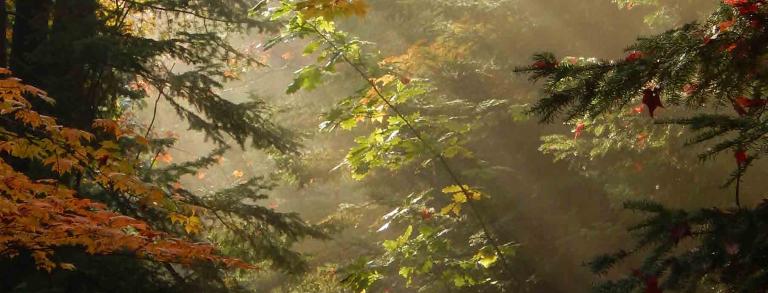IT IS THE twilight of the season. Outside, apricot-brown oak leaves glow in the morning sunlight, while pale yellow discs of cottonwood fall in great swirls, a round of carpet on the frosted lawn. This is my garden, one which germinated within me, naturally, as a wee child; fascinated by the beauty of plants. How many of us remember Grandma’s kitchen window ledges, and the wonders there? My grandma grew African violets, and even before I could speak I would stand, mesmerized, and stare at them.
I was born to grow. Once asked why I grew plants, my answer was that I could not NOT grow them; my soul is green, and a kaleidoscope of bloom color. It has been a long and satisfying journey, the wonder of the plant world being such that there remain hundreds of thousands of new species and varieties to discover.
In the garden, labor is transformed. Sometimes it seems I can wield a shovel for an entire day without tiring. Like the pond presently under construction in the lowest corner of the west lawn, now transformed into a vegetable garden and temporary holding area for all sorts: little red maple seedlings chosen out of hundreds in the woods for their precocious scalding fall colors; lilium awaiting permanent placement
in the spring; great gobs of antique rose hips, crushed, buried and hopefully hidden from the birds; and scattered spring bulbs. Why not take advantage of the vegetable garden? The bulbs will go dormant before the squash or pumpkins lurch wildly in every direction.
Time to dig a bit more and make that corner pond that will house Mr. Koi and my dear other fishes. They are part of my horticultural circle now. I drain 6 gallons (23 L) of fishy rich aquarium water 1-2 times a week to water the exploding collection of primulina, petrocosmea
and other gesneriad gems that will keep me in color and joy this winter. Fresh water goes in the tank, and my fish have doubled in size in a few short months. Indeed, they are eating me out of house and home. Glad to know they enjoy the tough, beaten outer leaves of romaine lettuce that I used to compost.
The unfinished pond testifies to the challenges faced here in northeastern Michigan. The glaciers carved our state and our magnificent lakes, scraping the limestone bedrock, leaving it exposed in places. It left pure sand for me. In the past ten thousand or so years, the low swampy areas accumulated up to a foot of pure organic matter. Most years it remains submerged all season, as the water table is that high. Water, yes, we are blessed here, there is hardly a spot that one can’t dig down three feet (1 m) and have water pour in through the coarse sand. We have slight ridges in the forest, and there the humus is only perhaps 1-2 inches (2.5 – 5 cm) deep, on that fossil beach of pure sand. Acidic conditions predominate. Acres and acres of wintergreen (Gaultheria procumbens), blueberries, kalmia. Trailing arbutus (Epigaea repens) runs rampant under the trees, creeps across the primitive roads cut decades ago through the forest, where tiny-leafed seedlings offer themselves for transplant. This diverse environment was my first, childhood, horticultural schooling.
My rock garden will come in time, but most definitely be a shaded and moist permutation. Our native woodland plants often crawl epiphyte-like up thickly mossed tree trunks. The forest offers an unlimited supply of limestone that I began collecting this summer. I’ve been collecting stunning fossil coral for years and years – the hundred acre Devonian limestone quarry, now abandoned along Lake Huron, offers inspiration with every rock gathering, fossil hunting expedition. This is an otherworldly place, where plants find tiny places to thrive, sometimes stunted, hundreds of bonsai-like white cedar and black spruce. Cypripedium calceolus in the full scalding sun, roots content in pure limestone gravel. Fringed gentian and Aquilegia canadensis, spiranthes and arctostaphylos.
Presently, I am looking at companion plants for my beloved primula. My love of these garden gems began in 1975, with a packet of grocery store polyanthus. It continues as I’ve collected and bred these delights rather seriously for the past 20 years. Species, acaulis, mutant forms, all the glorious Barnhaven strains. For me, there is no greater spring impact than their saturated colors. Colors that sing wordlessly, glow with such vibrancy that the external world disappears and I feel only joy.
This season, I noted the tiny white star flowers of Coptis trifolia, the aptly named goldthread – for its fine rhizome – blooming during primula season. I’ve always adored this little plant. Evergreen leaves shiny as plastic parsley, this is what I need between the primrose clumps. Delicate yet tough, it will never negatively impact even the tiniest juliana. This idea led me to the imagination of evergreen woodland lawn patches. The rabbits and deer will munch the fully expanded hosta, leaving spikes of what Mother and I laughingly call “celery,” but never touch the primroses. The only pest troubling them is an ever pesky eighty-five year old man on a riding lawnmower. Forgive me, but it seems testosterone and gasoline are more dangerous to the environment than wildfire. So, yes, the evergreen lawn substitute will begin slowly under the massive old white pine in the front yard: gaultheria, coptis, Epigaea repens, carefully sited Goodyera pubescens, semi-evergreen woodland ferns of yet undetermined identification, and mosses which glow radiant and shimmering velvet against the brown- grey-white winter now just days away. Here, where this drab landscape extends a full 5 months, this green will tantalize when the snow cover is thin, and greet us in spring with first melt and the perky brightness of crocus, eranthis, and Primula vulgaris subsp. sibthorpii.
Primula vulgaris subsp. sibthorpii took me a good 10 years to track down, when finally I found the seed staring me in the face on the Jelitto website. In white and all shades of pink, even to rich streetwalker shades, these flowers delight with the first blooms of spring, well in advance of foliage. Indeed, the flowers are often there under the snow, on single stalks initially only a centimeter tall, extending to inches
as the blooms age. I shall nurture carpets of them. P. sibthorpii would wear out its rock garden welcome with the mature summer foliage. The kitten cute of bloom roars into king-of-the-jungle, awkward leaves up to 10 inches (25 cm) long. One could easily disguise this, tucking it under a choice deciduous shrublet, or carefully surrounding it with well behaved herbaceous favorites. Too, for best appreciation of the flowers, it requires the autumn or very early spring removal of the old leaves.
I will be using P. sibthorpii in my continued primula breeding; the problem being it blooms so early that only P. acaulis is available for crossing, and it appears here only barely in time. This is my future challenge. One of many.
The garden is my sanctuary. Here, there is patience, hope, and peace. There is no past, there is no future other than the comforting expectation of next year's bloom, there is only the present beauty.


